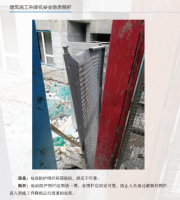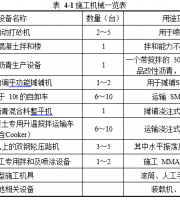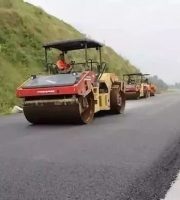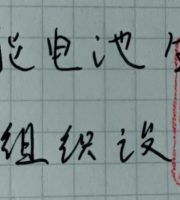Acceptance criteria: define relevant acceptance criteria and acceptance conditions according to the construction process.
2.
Construction management personnel: list of management personnel and post responsibilities (e.g.
2.
[forwarding] share the divisional and subdivisional works related to blasting works: VI.
2.
Labor plan.
the name, construction time and specific responsible personnel of dangerous projects and safety warning signs in dangerous areas shall be announced at a prominent position on the construction site.
(2) Preparation basis 1.
Acceptance procedures and personnel: determine the composition of acceptance personnel according to the specific acceptance procedures (relevant principals of construction, survey, design, construction, supervision, monitoring and other units).
3.
Organizational guarantee measures: safety organization, safety guarantee system and safety responsibilities of corresponding personnel.
4.
Engineering geological and hydrogeological conditions: description of strata related to the project (including name, thickness, state, property, physical and mechanical parameters, etc.).
Acceptance contents: deformation and integrity of the structure of the concealed excavation project, deformation of the surrounding environment, groundwater control, etc.
Technical measures: safety guarantee measures, quality and technical guarantee measures, civilized construction guarantee measures, environmental protection measures, seasonal construction guarantee measures, etc.
2.
Surrounding environmental conditions: (1) plan and section of the location relationship between the surrounding environment and the project, and mark the type of surrounding environment.
3.
Construction schedule: construction schedule of concealed excavation works, specific to the schedule of subdivisional works.
Overview and characteristics of concealed excavation works: project location, design overview and project scale (structural form, size, buried depth, etc.), commencement time and planned completion time, etc.
Construction layout: the layout of the proposed project area, living area and office area, roads, processing area, material storage yard, mechanical equipment, temporary water, electricity and fire fighting, etc.
Full time safety personnel: list of full-time safety production management personnel and post responsibilities.
Risk identification and classification: risk factor identification and safety risk classification of concealed excavation works.
(2) engineering importance, number of floors, structural form, foundation form, foundation buried depth, construction and completion time, structural integrity and service condition of adjacent buildings (structures).
Construction calculation sheet: grouting volume and grouting pressure, shield tunneling parameters, pipe jacking (culvert) jacking parameters, reaction frame (or back), steel sleeve, frozen wall checking calculation, groundwater control, etc..
5.
(9) Calculation sheet and relevant construction drawings 1.
concealed excavation works (I) project overview 1.
Technical parameters: technical parameters of equipment (including selection and adaptability evaluation of main construction machinery and equipment, such as pipe jacking equipment, shield equipment, box culvert jacking equipment, grouting equipment and freezing equipment), excavation technical parameters (including excavation section size, excavation footage, etc.), and support technical parameters (material, structural composition, size, etc.).
for underground excavation works.
3.
(7) Acceptance requirements 1.
Emergency material preparation.
The geological and groundwater environment of the project shall be shown and marked when drawing the stratum profile Note structure location.
(5) Importance, nature, anti-seepage situation, water level, impact on concealed excavation works, etc.
Composition and responsibilities of emergency response leading group and emergency rescue group, including rescue, security, logistics, medical rescue, aftermath, emergency rescue workflow, contact information, etc.
4.
Monitoring measures: monitoring organization, monitoring scope, monitoring items and monitoring party Method, monitoring frequency, early warning value and control value, patrol inspection, information feedback, layout of monitoring points, etc.
Construction requirements: clarify quality and safety objectives and construction period requirements (commencement date and planned completion date of the project), planned commencement date and planned completion date of concealed excavation works.
Inspection requirements: materials used in concealed excavation project Component mobilization quality inspection, sampling inspection, inspection contents and standards of each process during construction.
2.
7.
(3) Importance, traffic load, road characteristics and use of adjacent roads.
(5) Construction guarantee measures 1.
3.
Project documents: construction contract (construction contracting mode), survey documents, design documents and construction drawings, geological disaster risk assessment report, safety risk assessment report, groundwater control expert review report, etc.
The type of aquifer, the thickness of aquifer and the elevation of top and bottom plate, the water abundance, permeability, recharge and discharge conditions of aquifer, the hydraulic connection between aquifers, the elevation and dynamic change of groundwater level.
project leader, project technical director, constructors, quality personnel, team leaders, etc.).
(6) Construction management, staffing and division of labor 1.
Process flow: general construction process flow of concealed excavation project and process flow of each subdivisional project.
Construction organization design, etc.
3.
3.
Emergency events (major hidden dangers and accidents) and their emergency measures.
Construction method and operation requirements: process flow and key points, common problems and preventive and treatment measures such as preparation before construction of concealed excavation project, groundwater control, support construction and earthwork excavation.
Responsible entities of all parties involved in the construction.
2.
2.
Contact information of all parties of property rights units such as surrounding buildings, roads and underground pipelines, and information of rescue hospital (name, telephone and rescue line).
(4) Construction technology 1.
3.
6.
4.
(4) importance, characteristics, buried depth and use of underground pipelines (including water supply, drainage, gas, heat, power supply, communication, fire protection, etc.).
Special operation personnel: list of licensed personnel and post responsibilities of special operation personnel.
Other operation personnel: list of other personnel and post responsibilities.
(3) Construction plan 1.
4.
3.
Legal basis: relevant laws, regulations, normative documents, standards, specifications, etc.
(8) Emergency response measures 1.
Material and equipment plan, etc.: mechanical equipment configuration, demand plan for main materials and revolving materials, input plan of main materials, requirements for physical and mechanical properties, detailed requirements for sampling and retest, and test plan.
2.






